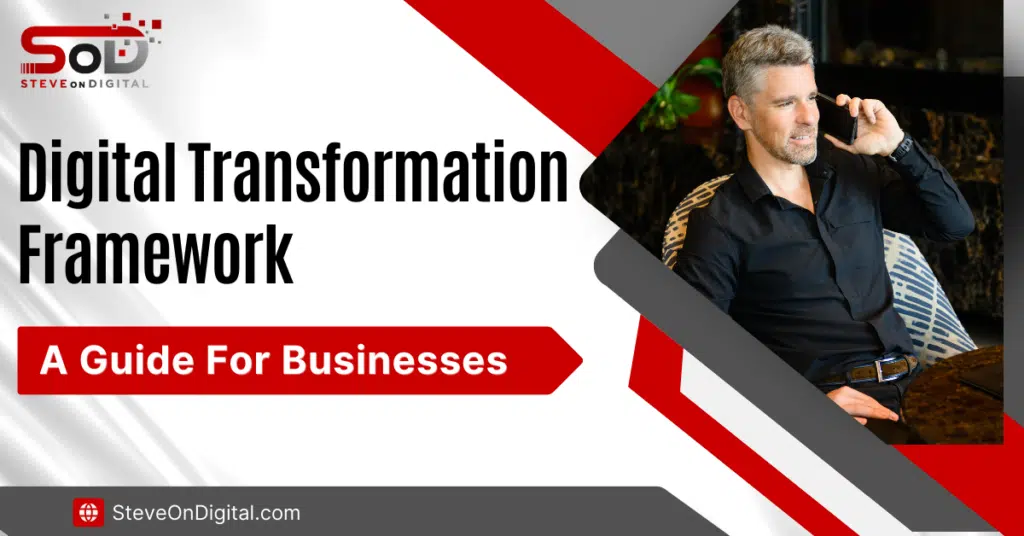Digital Transformation Framework | A Guide For Businesses

A digital transformation framework is a plan for using digital technologies in all parts of a business. This process fundamentally changes how a business operates and delivers value to customers. Digital transformation is essential in today’s fast-paced market. It helps businesses stay competitive and meet evolving customer expectations. The global market for digital transformation is projected to reach $3.4 trillion by 2026, highlighting its critical role in modern business strategies. Adapting to these changes is crucial for improving efficiency, enhancing customer satisfaction, and driving growth. I’m Steve, a digital transformation expert with a strong background in electrical engineering, an MBA, and a master’s in Project Management. I excel at helping SMEs navigate the next digital technology landscape with practical insights. Let’s begin! Understanding Digital Transformation Digital transformation means using digital technology in every part of a business. It changes how the business works and how it serves customers, creating new ways of doing things. Definition Of Digital Transformation Digital transformation encompasses the adoption of digital technologies to improve processes, enhance customer experiences, and drive business growth. It includes technologies like cloud computing, data analytics, artificial intelligence, and more. Importance Of Digital Transformation The significance of digital transformation cannot be overstated. It offers numerous benefits, such as improved efficiency, enhanced customer satisfaction, and increased agility. For instance, businesses that embrace digital transformation are better positioned to respond quickly to market changes and customer demands. Key Elements Of Digital Transformation Element Description Technology Integrating new digital tools and platforms to enhance operations and services. Strategy Developing a clear roadmap for digital initiatives aligned with business goals. Culture Fostering a culture that embraces change and innovation, encouraging continuous improvement. Components Of A Digital Transformation Framework A strong digital transformation framework that provides a structured approach to implementing digital changes. Technology Integration Successfully integrating new technologies into existing systems is crucial. This involves careful planning and execution to avoid disruptions and maximize benefits. Strategic Planning Having a solid strategy is vital for digital transformation. It should outline clear goals, objectives, and a timeline to guide the digital transformation process through. Organizational Culture A supportive organizational culture is essential. Encouraging a mindset open to change and innovation helps ensure the success of all digital transformation strategies and initiatives. Change Management Effective change management techniques are necessary to address resistance and ensure smooth transitions. This includes communication, training, and support to help business and it leaders and employees adapt to new technologies and processes. Building a Digital Transformation Strategy Creating a robust and effective digital transformation framework and strategy is a multi-step process that involves careful planning, resource allocation, and continuous evaluation. Here’s how I approach it, based on my experience and extensive research: Step Description Assessing Current State Evaluating existing systems, processes, and technologies to understand their current capabilities and limitations. Setting Goals And Objectives Aligning digital transformation goals with the overall business strategy to ensure alignment with broader objectives. Developing A Roadmap Creating a detailed plan with manageable tasks and realistic timelines to guide digital transformation efforts. Allocating Resources Investing in the right technology, budget, and skilled personnel to support and sustain digital transformation initiatives. Assessing Current State Before diving into digital transformation, it’s crucial to understand where your business stands. This means evaluating existing systems, processes, and technologies. Conduct interviews, surveys, and analyze documentation to identify pain points and areas for improvement. This assessment helps pinpoint what needs to change and sets a clear baseline for progress. Setting Goals And Objectives Setting clear, achievable goals is essential. Make sure your goals match your business plan so that digital changes help you reach your bigger goals. For instance, if your goal is to improve customer experience, you might aim to reduce response times using digital tools. Clear objectives help keep the digital transformation project focused and measurable. Developing A Roadmap A well-defined roadmap is your action plan. Break down your goals into manageable tasks with realistic timelines. Assign responsibilities and ensure everyone knows their role. This roadmap should be flexible enough to adapt to new challenges and opportunities but detailed enough to guide day-to-day activities. Allocating Resources Successful digital transformation requires the right resources. This includes budget, technology, and skilled personnel. Invest in training to upskill your team and ensure they’re equipped to handle new digital tools and processes. Allocate your budget wisely, focusing on technologies that offer the most significant impact and quick wins. Implementing The Digital Transformation Framework Implementation is where strategy meets action. Here are the best practices I follow: Pilot Programs Start with pilot programs to test and refine your approach. These small-scale projects help identify potential issues and opportunities without the risk of a full-scale rollout. Pilots also provide tangible results that can help gain buy-in from stakeholders. Scaling Up Once pilot programs prove successful, scale them up across the organization. This requires careful planning to ensure that the expanded implementation remains consistent and effective. Use lessons learned from pilot programs to improve the broader rollout. Continuous Improvement Digital transformation is an ongoing process. Regularly assess and refine your efforts to stay aligned with evolving business needs and technological advancements. Use data and feedback to drive continuous improvement and keep the digital transformation frameworks dynamic and relevant. Tools And Technologies In Digital Transformation Leveraging the right tools business models and technologies is vital for driving transformation: Technology Benefits Cloud Computing Scalability, flexibility, cost-efficiency. Supports efficient data storage and processing. Data Analytics Informed decision-making, understanding customer behavior, process optimization. Artificial Intelligence (AI) Automating tasks, enhancing decision-making, personalizing customer experiences. Mobile Technologies Enhancing accessibility and engagement, providing seamless customer experiences across devices. Cloud Computing Cloud computing offers scalability, flexibility, and cost-efficiency. It enables businesses to store and process data efficiently, supporting everything from everyday operations to innovative new services. According to Gartner, by 2026, global cloud spending is expected to reach $832 billion (Digital Adoption). Data Analytics Data analytics is crucial for informed decision-making. It helps businesses understand customer behavior, optimize processes, and uncover new opportunities. Implementing advanced analytics can

